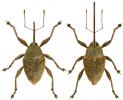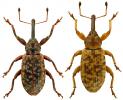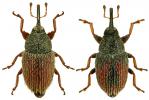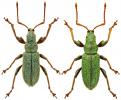Curculionidae
Common name:
WeevilsNumber of species:
493Size Range:
1-14mmTarsi:
4-4-4. Lobed or not.Images:
Description:
Worldwide this is the largest known family, with more than 60,000 described species, but in Britain it is second with 480 species, behind the Staphylinidae. The weevils are recognisable as a group from their small size (1-6mm), elbowed (geniculate) antennae, and elongated snout (the rostrum), although subfamily Scolytinae, the bark beetles, have deflexed heads without a rostrum and instead superficially resemble the Bostrichiidae. Even the Scolytinae still have the geniculate antennae and bi-lobed third tarsal segment of Curculionidae, however. The family is largely phytophagous and many species are restricted to a few or even one hostplant species. There are currently 14 subfamilies.
The two large subfamilies Curculioninae and Entiminae each contain just under a quarter of the British weevil species. Curculioninae contain the archetypal weevils, Curculio spp. Species are diverse, including leaf-miners, inquilines in galls, catkin-feeders, seed-feeders and leaf-feeders on a huge range of plants. Curculioninae also includes the flea-weevils of tribe Ramphini, which are notable for their habit of leaping to avoid disturbances. Entiminae are the broad-nosed weevils, recognisable by their short, comparatively broad rostrums. Several are pest species, including the notorious vine weevil Otiorhynchus sulcatus (Fabricius), and others are the familiar green leaf weevils, Phyllobius and Polydrusus spp.
Bagoinae is a small subfamily of semi-aquatic weevils which feed on waterweeds, particularly in drainage ditches. Most are rare and at least three are thought to be extinct in Britain.
Baridinae is a small group in Britain. The two Limnobaris spp. are relatively widespread, albeit locally distributed, on sedges, while the five Baris species are found in southern Engand, where they feed on herbaceous plants.
Ceutorhynchinae is another large subfamily, and a very diverse one. Most species are associated with one or a few species of herbaceous plant, including some species of Ceutorhynchus which can be pests on Brassica crops. Many species, however, are aquatic or semi-aquatic, chief of which is Eubrychius velutus (Beck), an entirely aquatic species which feeds on milfoils (Myriophyllum spp.).
Cossoninae is a distinct group of wood-living weevil species, a rich dark brown in colour and generally an elongate oblong in shape. Several species are partly synanthropic, occurring indoors in old floorboards and similar.
A small family of just four British species, Cryptorhynchinae contains three small species of Acalles, associated with dead twigs, and Cryptorhynchus lapathi (L.), the larvae of which bore the stems of Salix spp.
Cyclominae contains just two British species, both in genus Gronops. The native G. lunatus (Fabricius) is associated with spurreys (Spergularia spp) while G. inaequalis Boheman is a recent arrival.
Hyperinae is a relatively small subfamily, with 18 British species. Larvae are colourful and active, feeding openly on leaves, more like caterpillars than other weevil grubs. Several species of Hypera are known as the golden cage weevils for their habit of spinning a mesh cocoon of golden silk on the leaf surface to pupate within.
Lixinae contains 11 of our largest and rarest weevils, several of which are now thought to be extinct in Britain. Most of the remaining species, such as the 1992 arrival Lixus scabricollis Boheman, are found only in southern Britain.
Mesoptiliinae (formerly Magdalidinae) contains 8 species in Britain, all in genus Magdalis. Larvae are found beneath bark and adults can be beaten from the hostplant, mainly during June.
Molytinae is a slightly odd grouping of 17 weevil species including Hylobius abietis (L.), a large and abundant pest of conifer plantations and the exceedingly local Aconidium unguiculare (Aubé), found in moss and leaf litter from the south Devon cliffs and oak woods around Gweek in Cornwall. Perhaps the most unusual member of the group is Syagrius intrudens C.O. Waterhouse, a member of an Australian genus but which has not yet been found there and so the small, scattered British sites contain the only known world populations of the species.
Orobitidnae contains just one British species, Orobitis cyaneus (L.). This is a small species, very similar in appearance to the seed capsules of various Violaceae, which are also the larval foodsource.
Subfamily Scolytinae is a large group of bark- and ambrosia-beetles. Distinctive amongst the weevils by their lack of a rostrum, these are all associated with dead wood, particularly conifers, and some species can be forestry pests.
















